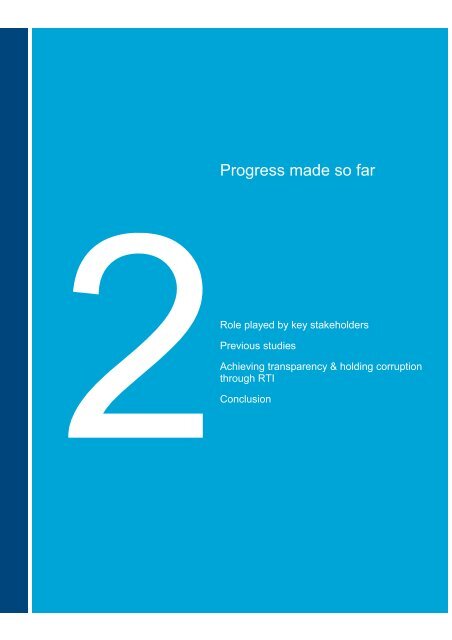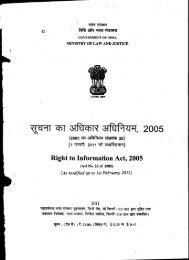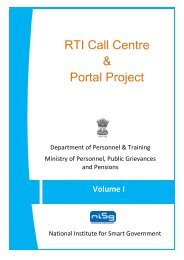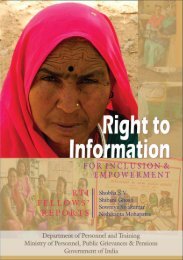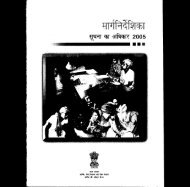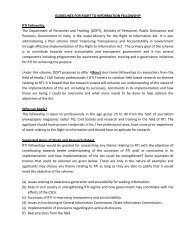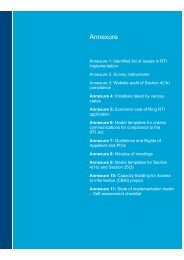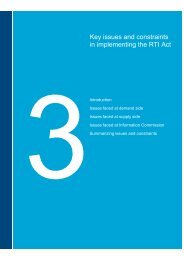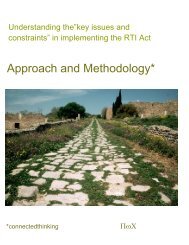Progress made so far - Right to Information Act
Progress made so far - Right to Information Act
Progress made so far - Right to Information Act
Create successful ePaper yourself
Turn your PDF publications into a flip-book with our unique Google optimized e-Paper software.
<strong>Progress</strong> <strong>made</strong> <strong>so</strong> <strong>far</strong><br />
Role played by key stakeholders<br />
Previous studies<br />
Achieving transparency & holding corruption<br />
through RTI<br />
Conclusion<br />
PricewaterhouseCoopers Final Understanding the “Key Issues and Constraints” in implementing the RTI <strong>Act</strong>*<br />
26
The objective of the RTI <strong>Act</strong> (as enshrined in its preamble) is <strong>to</strong> establish a practical regime for citizens <strong>to</strong> access<br />
information held by Public Authorities. This in turn will lead <strong>to</strong> increased transparency and accountability at the Public<br />
Authorities. More than three years have passed since the enactment of the RTI <strong>Act</strong> and it is the right time <strong>to</strong> take s<strong>to</strong>ck<br />
of what has been achieved by giving access <strong>to</strong> information held by Public Authorities <strong>to</strong> the citizens. This chapter<br />
highlights the contribution <strong>made</strong> by various stakeholders and how RTI has <strong>made</strong> an impact at the grassroots levels. It<br />
further details out/analyzes the nature of information <strong>so</strong>ught under RTI.<br />
2.1. Role played by key stakeholders<br />
RTI <strong>Act</strong> has the potential <strong>to</strong> bring in a <strong>so</strong>cio-economic<br />
revolution, provided that various agencies take up their<br />
responsibilities as per the spirit of the <strong>Act</strong>. The Civil<br />
Society Organizations and Media can act as pressure<br />
points, but most of the execution is <strong>to</strong> be carried out by<br />
the appropriate Governments and <strong>Information</strong><br />
Commissions. Based on the secondary research and<br />
discussions with key stakeholders, the key roles played<br />
by various entities 10 are:<br />
Civil Society Organizations.<br />
• Civil Society Organizations and <strong>so</strong>cial activists are<br />
enhancing the reach and awareness of RTI among<br />
the masses. It is mostly with the support of the <strong>so</strong>cial<br />
activists and Civil Society Organizations that a per<strong>so</strong>n<br />
in a village is able <strong>to</strong> use the RTI <strong>Act</strong> for ensuring his<br />
basic rights. However given the geographical size &<br />
population, the reach of Civil Society Organizations<br />
and <strong>so</strong>cial activists is limited.<br />
• Civil <strong>so</strong>ciety has al<strong>so</strong> <strong>made</strong> contribution <strong>to</strong>wards<br />
training of PIOs and AAs and <strong>made</strong> them aware of<br />
their roles and responsibilities under the RTI <strong>Act</strong>.<br />
Media<br />
• Media has played an important role in generating<br />
awareness at a mass scale. While there has been no<br />
major media campaign for promoting the usage of RTI<br />
<strong>Act</strong>, nonetheless the awareness on the <strong>Act</strong> has been<br />
generated through news articles based on<br />
RTI investigation.<br />
• In the context of RTI implementation, journalists at<br />
times have played a dual role – as the users of RTI<br />
<strong>Act</strong> and as watchdogs, moni<strong>to</strong>ring and scrutinizing the<br />
implementation of the <strong>Act</strong>.<br />
10 Entities created through this <strong>Act</strong>, have not been mentioned<br />
• Various media entities have contributed <strong>to</strong> the mass<br />
awareness and bringing in transparency through their<br />
websites.<br />
Central Government<br />
• Basic institutional structure/processes has been set<br />
up as per the RTI act requirement (like appointment of<br />
<strong>Information</strong> Commissioners, PIOs, section 4(1) (b)<br />
etc.)<br />
• Department of Per<strong>so</strong>nnel & Training has been <strong>made</strong><br />
the Nodal Department for the RTI implementation at<br />
the Central level.<br />
• A centrally-spon<strong>so</strong>red scheme for capacity building<br />
and awareness generation for effective<br />
implementation of the RTI <strong>Act</strong> has been<br />
commissioned in the 11 th five year plan.<br />
• UNDP with DoPT as an implementation partner<br />
launched the “Capacity Building for Access <strong>to</strong><br />
<strong>Information</strong>” project. This project aimed at 11 :<br />
- Capacity building of Government officials at<br />
Central, State and district level, especially those<br />
of the identified Department with maximum<br />
public interface<br />
- Generating awareness among the citizens<br />
- Establishment of institutional mechanism<br />
/processes for enhanced citizen Government<br />
interface and for addressing citizens’ views<br />
and feedback<br />
- Business Process Re-engineering<br />
- Expansion of information in public domain<br />
- Research communications and Advocacy<br />
- Network of practitioners<br />
11<br />
UNDP Project of the Government of India (Project No. IND/03/024). Details provided<br />
in Annexure 10<br />
PricewaterhouseCoopers Final Understanding the “Key Issues and Constraints” in implementing the RTI <strong>Act</strong>*<br />
27
State Government<br />
• Various State Governments had already enacted laws<br />
for access <strong>to</strong> information in <strong>so</strong>me form or the other,<br />
like –Tamil Nadu (1997), Goa (1997), Rajasthan<br />
(2000), Karnataka (2000), Delhi (2001), Maharashtra<br />
(2002), Madhya Pradesh (2003), Assam (2002) and<br />
Jammu and Kashmir (2004).<br />
• Post the enactment of the Central <strong>Act</strong>, <strong>so</strong>me State<br />
Governments have taken innovative initiatives in line<br />
with the spirit of the <strong>Act</strong>. The key initiatives are:<br />
- Jankari Call Centre, Government of Bihar: Bihar<br />
Government has initiated a six seater call centre.<br />
This call centre facilitates a caller in drafting the<br />
RTI application and the fee is collected through<br />
the phone bill. Requisite changes have been<br />
<strong>made</strong> in the rules for acceptance of the<br />
application through this channel. Similarly RTI<br />
Helpline in Bangalore is providing RTI<br />
information <strong>to</strong> citizens<br />
- <strong>Information</strong> Commission “regional offices” in<br />
Maharashtra: As per Section 15(7) of the RTI<br />
<strong>Act</strong>, the SIC can increase their geographical<br />
reach through establishing offices at other<br />
places. Maharashtra has created 5 offices of<br />
2.2. Previous studies<br />
the <strong>Information</strong> Commission in Pune, Mumbai,<br />
Aurangabad, Amravati and Nagpur <strong>to</strong> enable<br />
citizens <strong>to</strong> approach the most convenient<br />
regional office<br />
- “Train the Trainer” concept in Assam: Assam has<br />
adapted a “Train the Trainers” concept, where the<br />
Government trains the CSOs/NGOs <strong>to</strong> impart<br />
training <strong>to</strong> citizens on RTI in order <strong>to</strong> maximize the<br />
reach of RTI and ensure that there is local<br />
ownership and sustainability<br />
- Review of Public Authorities by Andhra Pradesh<br />
State <strong>Information</strong> Commission<br />
- Public hearings at the district headquarters by<br />
Kerala State <strong>Information</strong> Commission<br />
- The CIC website has a feature for online<br />
submission of complaints and second appeals<br />
While the contribution <strong>made</strong> by the above entities is<br />
acknowledged, there is still a long way <strong>to</strong> go <strong>to</strong> establish<br />
transparency and accountability through RTI. The<br />
expectations/actions required from the appropriate<br />
Governments are significant, <strong>so</strong>me clearly articulated in<br />
the <strong>Act</strong> and <strong>so</strong>me are implied. This report tries <strong>to</strong> bring<br />
out both the aspects in its recommendations.<br />
In the last 3 years, there have been a large number of studies carried out by various organizations assessing various<br />
aspects of RTI regime. A significant number of them have focused on tracking the status of RTI at various levels and<br />
emerging recommendations. These studies were referenced while identifying the preliminary list of implementation<br />
issues. Some of the key studies used as reference material are mentioned below:<br />
Second Administrative Reforms Commission (2006)<br />
The Second Administrative Reforms Commission was constituted <strong>to</strong> prepare a detailed blueprint for revamping the public<br />
administration system. The Commission was given wide terms of reference covering all aspects of public administration. The<br />
Commission in its first report decided <strong>to</strong> analyze and give recommendations on the freedom of information as the <strong>Right</strong> <strong>to</strong><br />
<strong>Information</strong> <strong>Act</strong>.<br />
Tracking <strong>Right</strong> <strong>to</strong> <strong>Information</strong> in eight states - 2007<br />
This report was developed by Society of Participa<strong>to</strong>ry Research in Asia (PRIA). This study aimed at analysing the<br />
experiences of information seekers in accessing information under the RTI <strong>Act</strong> using Civil Society Organisations. Further, this<br />
study captured the details of working of State <strong>Information</strong> Commission and State Nodal Department for RTI implementation.<br />
PricewaterhouseCoopers Final Understanding the “Key Issues and Constraints” in implementing the RTI <strong>Act</strong>*<br />
28
<strong>Act</strong>ion Research Villages: A <strong>Right</strong> <strong>to</strong> <strong>Information</strong> Campaign<br />
This report was published under the Poorest Area Civil Society Programme (PACS). The PACS was aimed <strong>to</strong> help poor<br />
people in 108 poorest districts of the country. The programme targeted <strong>to</strong> reach out <strong>to</strong> over nine million households and<br />
approximately over 45 million populations, spread across six States. More than 83% of the populations reached were from<br />
Scheduled Castes (38%), Scheduled Tribes (21%), Other Backward Classes (23%) and 17% from general class.<br />
Under this program one of the reports generated was “<strong>Act</strong>ion Research Villages – A <strong>Right</strong> <strong>to</strong> <strong>Information</strong> Campaign”. The aim<br />
of this study was <strong>to</strong> conduct a RTI campaign in remote villages of India. Under this about 300 RTI applications were filed by<br />
citizens in each of the 5 villages taken up under this campaign (1500 in <strong>to</strong>tal). The major objectives of this study were <strong>to</strong>:<br />
• Study and moni<strong>to</strong>r the impact of extensive use of RTI over a course of one year and replicating the experiment<br />
elsewhere if successful<br />
• To train and encourage as many people as possible <strong>to</strong> start using RTI<br />
• To facilitate the formation of user groups, support groups and networks of citizens using RTI<br />
• To inculcate within the community the practice of moni<strong>to</strong>ring various actions, programmes and schemes run by<br />
the Government<br />
• The findings and case studies have provided insights <strong>to</strong> the key issues and constraints in the implementation of<br />
• RTI at the grassroot level.<br />
2.3. Achieving transparency and holding corruption through RTI<br />
During the period, Oc<strong>to</strong>ber 2005 <strong>to</strong> present day, it has become evident that there are many anticipated and<br />
unanticipated consequences of the <strong>Act</strong>. The mandate of this study was <strong>to</strong> study these consequences, how they impact<br />
the transparency regime in the country and <strong>to</strong> suggest changes for improving the RTI regime in the country. This<br />
section provides an analysis of RTI’s impact based on primary and secondary research. Based on these findings we<br />
can conclude that RTI <strong>Act</strong> can have an impact even in the remote villages, if properly facilitated and guided.<br />
2.3.1. Nature on information being requested (based on primary study)<br />
RTI has become a weapon in the hands of common citizens <strong>to</strong> fight for their rights. It is not surprising that the usage of<br />
RTI has been in the areas where citizens had <strong>to</strong> struggle <strong>to</strong> get what was rightfully theirs. An analysis of the information<br />
<strong>so</strong>ught under the RTI <strong>Act</strong> (as per the data collected as a part of this study) is provided in Figure 2.1. It may be observed<br />
that more RTI applications are filed in departments which impact quality of life of a common citizen.<br />
Figure 2.1: Classification of <strong>Information</strong> <strong>so</strong>ught under RTI<br />
Others<br />
Taxation Related Issues<br />
<strong>Information</strong> about other business<br />
Other Government Ministries/departments operations<br />
Panchayats/Municipal Departments/ Civic Bodies etc<br />
5%<br />
6%<br />
PricewaterhouseCoopers Final Understanding the “Key Issues and Constraints” in implementing the RTI <strong>Act</strong>*<br />
29<br />
10%<br />
29%<br />
39%
2.3.2. Impact of RTI at grassroot level<br />
PwC (in as<strong>so</strong>ciation with Development Alternatives) had managed a program, on the Poorest Areas Civil Society<br />
(PACS) Programme for 7 years, ending in 2007 (mentioned previously in section 2.2). Some of the analysis and<br />
findings of the study are presented here with a view <strong>to</strong> highlight how RTI <strong>to</strong>uches the life of a common villager and how<br />
profoundly this <strong>Act</strong> has the power <strong>to</strong> help these people. This campaign was carried out in five districts of Uttar Pradesh,<br />
namely Bahraich, Faizabad, Chitrakoot, Banda and Allahabad. This campaign (“Mere Gaon ka Sawal”) was controlled<br />
and supported constantly with the help of <strong>so</strong>cial workers from various non-profit agencies including Kabir and<br />
Parivartan in Delhi, ABSSS in Chitrakoot and Dehat Sanstha in Bahraich.<br />
During the campaign one of the discussions was focused on identification of villagers’ interaction with the Government<br />
and areas where they felt a non-responsive attitude of the Government officials. The list of issues generated was:<br />
1. Inconsistencies in the Public Distribution System<br />
2. Inconsistencies in the BPL ration cards<br />
3. Inconsistencies in the construction of roads, etc., from Gram Panchayat funds<br />
4. Villagers not receiving Voter ID cards<br />
5. Non-receipt of minimum wages at Govt. works<br />
6. Irregularities in scholarship distribution<br />
7. Bad quality food served under the Mid Day<br />
Meal scheme<br />
8. Distribution of free school uniforms and books<br />
9. Bad quality of school uniforms (wherever distributed)<br />
10. Non-availability of sports equipments in schools and colleges<br />
11. Absence of Teachers in schools<br />
12. Irregularities at the Anganwadi Centres<br />
13. Auxiliary Nurse Midwife not visiting the primary health care centres<br />
14. Free treatment and medicines not given at the Government hospitals<br />
15. Absence of any irrigation facility in the village<br />
16. Forest Department unjustifiably troubling the villagers<br />
17. The villagers not receiving the benefits of the forestation scheme<br />
18. Irregularities in the allotment of Gram Sabha land<br />
19. Irregularities in the selection of beneficiaries of Indira Awaas Yojna scheme<br />
20. Irregularities in the selection of the beneficiaries of Old Age and Widow Pensions scheme<br />
2.3.3. Analysis of the RTI Campaign under PACS<br />
To analyze the issues at a village level, the campaign (under PACS, referred above) was carried out in 2006-07. Under<br />
this program, 300 RTI applications were filed in each of the 5 villages. The experience and outcomes of the campaign<br />
were encouraging not only in the targeted villages but al<strong>so</strong> in the surrounding villages where the word of RTI had<br />
spread. In a few cases, there has been district-wide increase in the use of RTI. The findings are highlighted below.<br />
PricewaterhouseCoopers Final Understanding the “Key Issues and Constraints” in implementing the RTI <strong>Act</strong>*<br />
30
1. Number of RTI Applications filed<br />
Fig 2.2 : Number of Application filed on most common issues<br />
Others<br />
Home under Indra Awas Yojna<br />
Old age pension<br />
Nagrik suraksha sahayta yojna<br />
Drinking water<br />
Other human rights<br />
Aganwadi kendra<br />
Ration for individuals<br />
BPL ration cards<br />
Distribution of school dress<br />
Quality and Quantity of mid day meals<br />
Public Distribution System (Overall<br />
National Rural Employment Guarantee <strong>Act</strong><br />
Doc<strong>to</strong>r not coming <strong>to</strong> hospitals<br />
Forest land issue<br />
Daily wage of labour under government works<br />
Gram sabha land allotment for poor<br />
Teacher not coming <strong>to</strong> schools<br />
Scholarship in schools<br />
Gram panchayat development work<br />
Gram panchayat budget<br />
Link road <strong>to</strong> villages<br />
Sanitation<br />
Electricity<br />
1<br />
1<br />
2<br />
2<br />
2<br />
PricewaterhouseCoopers Final Understanding the “Key Issues and Constraints” in implementing the RTI <strong>Act</strong>*<br />
31<br />
3<br />
3<br />
3<br />
3<br />
3<br />
4<br />
4<br />
4<br />
4<br />
4<br />
4<br />
4<br />
5<br />
5<br />
5<br />
5<br />
0 2 4 6 8 10 12<br />
No. of RTI application filed<br />
7<br />
7<br />
10
2. Department-wise RTI application filed<br />
It was observed that the need for filing RTI applications was most in the places which were <strong>to</strong> deal with the delivery of<br />
the <strong>so</strong>cial benefit schemes. Most of these requests were either when the individual was not provided the benefit of a<br />
<strong>so</strong>cial scheme or issues linked <strong>to</strong> village level.<br />
Figure 2.2: Department wise ratio of application filed<br />
Food and Civil Supply dept<br />
Land and Revenue<br />
Gram Panchayat<br />
Education<br />
Wel<strong>far</strong>e<br />
Medical<br />
Forest<br />
Police<br />
Development Agencies<br />
Others<br />
3<br />
3<br />
4<br />
5<br />
8<br />
9<br />
14<br />
16<br />
21<br />
20<br />
0 5 10 15 20 25<br />
Figure 2.3: Level of Applications filed under RTI<br />
3. Success ratio in various issues<br />
Based on the RTI filed and subsequent follow up with the Government authorities, the villagers were able <strong>to</strong> succeed in<br />
various areas, where the Government Department <strong>to</strong>ok note of the issues and <strong>to</strong>ok necessary actions.<br />
While in no case, this is <strong>to</strong> claim that it has led <strong>to</strong> a significant change in the levels of corruption and accountability, but<br />
it shows a glimpse of how an informed citizenry – even if illiterate and marginalized – can bring in transparency &<br />
improvement in the system.<br />
Figure 2.4: % Success rate of filing RTI<br />
Teacher/Doc<strong>to</strong>r not coming<br />
Corruption in education system,school uniforms,<br />
scholarships, mid-day meals<br />
Free medicine in government hospitals<br />
Land patta for poor<br />
Corruption in PDS<br />
PricewaterhouseCoopers Final Understanding the “Key Issues and Constraints” in implementing the RTI <strong>Act</strong>*<br />
32<br />
50<br />
45<br />
40<br />
35<br />
30<br />
25<br />
20<br />
15<br />
10<br />
5<br />
0<br />
35<br />
Individual<br />
issues<br />
45<br />
Village level<br />
issues<br />
65%<br />
75%<br />
10<br />
District level<br />
issues<br />
85%<br />
90%<br />
100%<br />
5<br />
Policy<br />
issues<br />
0% 20% 40% 60% 80% 100% 120%
2.3.4. Success s<strong>to</strong>ries under this Campaign<br />
This section provides RTI success s<strong>to</strong>ries from rural and urban areas.<br />
Success s<strong>to</strong>ry 1: Attendance of the village<br />
school teacher<br />
In a Pre-Middle School in Panchampur village, situated 70<br />
kilometers away from the District Headquarters of Banda,<br />
a teacher was appointed for the school. However, the<br />
teacher was absent for most of the times.<br />
The workers and volunteers from the Delhi based<br />
organisations like Kabir and Parivartan, along with the<br />
local workers from the Chingari Sangathan under the<br />
‘<strong>Act</strong>ion Research Villages’ Campaign, propagated the use<br />
of the <strong>Right</strong> <strong>to</strong> <strong>Information</strong>. Finally, the villagers witnessed<br />
a ray of hope when they learned that they could question<br />
the Government and ask for information related <strong>to</strong> the<br />
attendance records, leave records and medical records of<br />
the absconding village school teacher. Fifteen villagers<br />
drafted an application regarding the same and filed a<br />
number of applications with the Primary Education Officer<br />
at the Banda District Head Quarters. They asked for the<br />
records of the teacher but al<strong>so</strong> questioned the Primary<br />
Education Department about the Department’s role and<br />
responsibilities in such situations.<br />
Immediate action was taken on the issue by the<br />
Department. The Primary Education Officer summoned<br />
the teacher the very next day and asked for an<br />
explanation. Living up <strong>to</strong> his accountability and<br />
responsibility, the officer appointed a new school teacher<br />
for the village school. The school was opened On the next<br />
day itself and regular teaching began in the school. An<br />
enquiry was ordered against the teacher and he<br />
was asked <strong>to</strong> report <strong>to</strong> the school instantly.<br />
The villagers were overwhelmed with the fact that their<br />
use of <strong>Right</strong> <strong>to</strong> <strong>Information</strong> could reap such instant<br />
results. – Source: PACS Report<br />
Success s<strong>to</strong>ry 2: Campaign report <strong>to</strong> the District<br />
Magistrate, Banda<br />
Another interesting facet of the campaign was the<br />
process of filing RTI applications in Banda (UP). A group<br />
of ten volunteers and villagers went <strong>to</strong> various offices for<br />
submitting their RTI applications. None of the applications<br />
could be filed easily. Most of the offices were ill-equipped<br />
for the task. One of the major problems faced during the<br />
filing process was that the clerks, and <strong>so</strong>metimes even<br />
the officers, appeared non-conversant and at times<br />
completely ignorant about the RTI <strong>Act</strong> itself. The<br />
applications were filed after a lot of trepidation, struggle<br />
and running around the offices. These experiences were<br />
submitted in the form of a report <strong>to</strong> the District Magistrate<br />
of Banda District, which had the desired effect and<br />
considerably improved the situation in most of the offices.<br />
– Source: PACS Report<br />
Success s<strong>to</strong>ry 3: Transparency in Public Distribution<br />
System for BPL Families<br />
The ‘Mere Gaon Ke Sawaal’ Campaign volunteers<br />
noticed that the residents of Nai Basti (Bahraich, UP)<br />
were al<strong>so</strong> facing the same problems as the other<br />
economically backward villages of the region. The<br />
‘Kotedar’ had been apathetic <strong>to</strong>wards their requests. The<br />
use of <strong>Right</strong> <strong>to</strong> <strong>Information</strong> by the villagers, the women<br />
being in majority, was successful in curbing the corruption<br />
that had seeped in the Public Distribution System <strong>to</strong> <strong>so</strong>me<br />
extent.<br />
When the campaign volunteers saw the BPL ration cards<br />
of the villagers, they found that no entries had been <strong>made</strong><br />
during February 2006 <strong>to</strong> December 2006. It was evident<br />
that the villagers had not received any ration in the said<br />
time period. Immediately, 51 village residents agreed <strong>to</strong><br />
file group RTI applications on the issue and demanded<br />
information regarding the acquisition and the distribution<br />
of the ration and al<strong>so</strong> asked for copies of the ration<br />
records. The applications were filed by the applicants<br />
per<strong>so</strong>nally after a lot of difficulty at the District Supply<br />
Office. Exactly within a fortnight, the Kotedar reached the<br />
village and narrated a long <strong>so</strong>b s<strong>to</strong>ry, which moved few of<br />
the innocent villagers <strong>so</strong> much that they even agreed <strong>to</strong><br />
take back their RTI applications. They very next day the<br />
Kotedar brought a mini bus <strong>to</strong> the village along with<br />
“pooris” <strong>made</strong> with one quintal flour and asked the<br />
villagers <strong>to</strong> come <strong>to</strong> the SDM’s office and take back their<br />
RTI applications. But, the women of the forest village<br />
rights forum refused <strong>to</strong> do <strong>so</strong>. This initiative by the women<br />
of the village encouraged the other villagers and they al<strong>so</strong><br />
refused <strong>to</strong> take back their RTI applications. The Kotedar<br />
trying another of his tactics, one day announced in the<br />
village that all those who requested for information can<br />
collect it from him. When few villagers reached <strong>to</strong> take the<br />
information, they were forced <strong>to</strong> make thumb imprints on<br />
a blank paper. The Dehat Sanstha volunteers<br />
immediately reported this scam <strong>to</strong> the SDM. Finally, the<br />
Kotedar was suspended. – Source: PACS Report<br />
Success s<strong>to</strong>ry 4: School uniforms distributed at the<br />
end of the December Session<br />
Despite several claims of the Government, school<br />
uniforms of the session – December 2006-07 – were not<br />
PricewaterhouseCoopers Final Understanding the “Key Issues and Constraints” in implementing the RTI <strong>Act</strong>*<br />
33
distributed among the students of the Gulrahai Primary<br />
School in Allahabad. Workers from KABIR and ABSSS<br />
conducted a meeting with the villagers of Gulrahai and<br />
educated them on the RTI <strong>Act</strong>. Immediately thereafter,<br />
nine parents prepared an RTI application and questioned<br />
the administration regarding the school uniforms of the<br />
children. In the first week of January 2007, the school<br />
dresses were distributed <strong>to</strong> the children. Similarly, in the<br />
Bharthaul Village primary school of Chitrakoot district,<br />
Success s<strong>to</strong>ry 5: Exposing corruption in medicine<br />
procurement at Public Sec<strong>to</strong>r Unit<br />
Applicants belonging <strong>to</strong> Anuppur, Madhya Pradesh and<br />
Koria district of Chhattisgarh filed RTI applications with<br />
the PIO of South Eastern Coal Fields Ltd. (SECL) situated<br />
at its head office in Bilaspur during the months of<br />
February – April 2006. They <strong>so</strong>ught the following<br />
information–<br />
1. Names of all medicines procured by SECL for<br />
distribution through its primary health centres and its<br />
OPD clinics in the Hasdev coal mines area during the<br />
financial year 2005-06. (They cater exclusively <strong>to</strong> the<br />
employees of SECL and their families)<br />
2. Quantity of medicines procured during the same<br />
period.<br />
3. Supply price of each item.<br />
4. Copies of all purchase orders issued by SECL for<br />
these medicines.<br />
5. Name and contact details of suppliers who bagged<br />
the purchase order.<br />
All three applicants received the requested information<br />
within the 30 day deadline stipulated in the RTI <strong>Act</strong>.<br />
Armed with these documents, applicants worked for<br />
several weeks crosschecking the data along with a team<br />
of about 25 committed volunteers. Based on the research<br />
it was found out that fictitious companies were shown as<br />
suppliers of luxury items in the name of procurement of<br />
medical supplies.<br />
school dresses were not distributed among the children till<br />
December. Under ‘Mere Gaon Ke Sawaal’ Campaign,<br />
KABIR & ABSSS conducted a meeting with the villagers<br />
of Gulrahai and educated them on the RTI <strong>Act</strong>. The very<br />
next day, parents of these children submitted an RTI<br />
application with the District Education Officer and within<br />
15 days, school dresses were distributed and a video<br />
shoot of the court was al<strong>so</strong> conducted. –<br />
Source: PACS report<br />
Next, the volunteers cross checked the rates at which the<br />
medicines had been supplied only <strong>to</strong> find that the retail<br />
outlets <strong>so</strong>ld the same items a lot cheaper.<br />
These details were published in local magazine popular in<br />
the coal mining belt of Madhya Pradesh and<br />
Chhattisgarh. Thereafter, the Vigilance unit instituted a<br />
formal investigation and action against the concerned<br />
officials was initiated<br />
Source:http://cic.gov.in/bestpractices.htm<br />
Success s<strong>to</strong>ry 6: Payment of pension dues from<br />
Railways<br />
“Payment of interest on arrears due on account of<br />
recomputation of pension and other retirement benefits as<br />
a result of implementation of Supreme Court’s Judgment<br />
dated 25-07-1997 in CA No 4174/88of 1995 and other<br />
tagged SLPs”<br />
Indian Railway Pensioners As<strong>so</strong>ciation Bhavnagar<br />
Division of Western Railway, over the years, submitted<br />
hundreds of representations <strong>to</strong> GM Western Railway &<br />
DRM Bhavnagar <strong>to</strong> get the payment in the above case.<br />
137 specific cases of non-payment were filed in the<br />
pension Adalat, but nothing happened. When, a request<br />
under RTI ACT 2005 was submitted <strong>to</strong> CPIO Western<br />
Railway for disclosing the rea<strong>so</strong>ns for not implementing<br />
the judgment of the Apex court, things started moving and<br />
the Western Railway accepted the liability for making<br />
payment and all the Divisions of Western Railway were<br />
advised <strong>to</strong> take immediate steps for making payment.<br />
Source: http://cic.gov.in/bestpractices.htm<br />
More success s<strong>to</strong>ries<br />
There are numerous other success s<strong>to</strong>ries available on various sites such as : http://www.rtiindia.org/forum/,<br />
:http://www.parivartan.com/home.asp, http://rti.aidindia.org, http://cic.gov.in/bestpractices.htm, http://www.sakshitrust.org/,<br />
www.satyamevajayate.info.<br />
The objective of these case studies has been <strong>to</strong> generate awareness amongst citizens on how the RTI <strong>Act</strong> can beused effectively.<br />
PricewaterhouseCoopers Final Understanding the “Key Issues and Constraints” in implementing the RTI <strong>Act</strong>*<br />
34
2.4. Conclusion<br />
The success s<strong>to</strong>ries range from highlighting scams worth crores <strong>to</strong> ensuring<br />
attendance of the sweepers in cities <strong>to</strong> identifying lost postal orders etc. The<br />
areas of corruption/ inefficiencies were known earlier in the Government, but<br />
citizens could not take recourse. However with the advent of the RTI <strong>Act</strong>,<br />
citizens have found a <strong>to</strong>ol <strong>to</strong> bring in transparency and accountability at all<br />
levels of Governance. In particular, the RTI <strong>Act</strong> has a much higher impact on<br />
the quality of life of the poor and marginalised section of the <strong>so</strong>ciety.<br />
However, the power of the <strong>Act</strong> is still <strong>to</strong> be fully realized. The citizens,<br />
Government, media and Civil Society Organizations need <strong>to</strong> do a lot <strong>to</strong> attain<br />
the intended objective of the <strong>Act</strong> and <strong>to</strong> address various issues and<br />
constraints in accessing the information under the <strong>Act</strong>.<br />
The subsequent section of the report highlights and quantifies many issues<br />
that plague the implementation aspect.<br />
PricewaterhouseCoopers Final Understanding the “Key Issues and Constraints” in implementing the RTI <strong>Act</strong>*<br />
35


